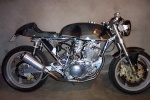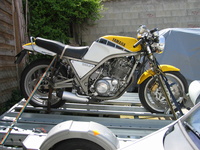| Novembre 2024 | | Lun | Mar | Mer | Jeu | Ven | Sam | Dim |
|---|
| | | | | 1 | 2 | 3 | | 4 | 5 | 6 | 7 | 8 | 9 | 10 | | 11 | 12 | 13 | 14 | 15 | 16 | 17 | | 18 | 19 | 20 | 21 | 22 | 23 | 24 | | 25 | 26 | 27 | 28 | 29 | 30 | |  Calendrier Calendrier |
|
| Statistiques | Nous avons 685 membres enregistrés
L'utilisateur enregistré le plus récent est jorock432
Nos membres ont posté un total de 78221 messages dans 5599 sujets
|
| Sondage | | | Comment allons renouveler l'executif | | 1- Election d'un nouveau secrétaire | | 94% | [ 15 ] | | 2- Renouvellement complet de l'executif | | 6% | [ 1 ] |
| | Total des votes : 16 |
|
|
| | valeur de dépression pour réglage carbu |  |
| | | Auteur | Message |
|---|
Tof

Nombre de messages : 660
Age : 63
Localisation : 21 - Talant
Date d'inscription : 22/12/2009
 |  Sujet: valeur de dépression pour réglage carbu Sujet: valeur de dépression pour réglage carbu  Sam 16 Jan - 9:41 Sam 16 Jan - 9:41 | |
| Bon je vais peut-être pourrir le forum de questions à la c-n mais maintenant que j'ai le moulbif faut que j'y mette les mains pour lui faire une toilette complète... Est-ce quelqu'un connait s'il y a un moyen de mesurer la dépression au caubu et les valeurs à trouver (régime moteur, mm de dépression ,) je voudrai dans un premier temps m'occuper du bon réglage de la carburation, filtre à air, cable de starter compris.... T'en qu'à faire de mourrir étouffé sous le casque, que ce soit de ma faute et pas des réglages  Tof&manomètre | |
|   | | guytan

Nombre de messages : 687
Age : 58
Localisation : Au bout du bout (après la flaque, c'est New-York)
Date d'inscription : 10/11/2007
 |  Sujet: Re: valeur de dépression pour réglage carbu Sujet: Re: valeur de dépression pour réglage carbu  Sam 16 Jan - 11:05 Sam 16 Jan - 11:05 | |
| La valeur de dépression n'est utile que pour la synchronisation des multicylindres, pour que la combustion soit à peu près égale dans chaque chambre.
Ce qui nous importe, c'est la qualité de la combustion. un mélange trop pauvre va faire chauffer exagérément le moteur et perdre de la puissance, un mélange trop riche va consommer trop, encrasser rapidement, et pour la puissance, c'est pareil que l'inverse.
Avant l'arrivée du sans plomb, on pouvait estimer la richesse en démontant la bougie et en regardant l'aspect des électrodes (avec un protocole strict, genre couper le contact à 6000 tours en fermant les gaz, débrayer et freiner simultanément pour ne pas foutre la lecture en l'air).
De nos jours, on utilisera plus à profit la sonde lambda d'une petite voiture, mais ça oblige à percer un collecteur d'échappement et d'y souder une douille filetée... Une fois les réglages effectués, ce tube pourra être changé pour un standard ou la douille bouchée par une vis.
Sinon, y'a le feeling du vieux pro du carbu, mais bon... Faut se cantonner à une marque (voire un modèle) pour faire ses armes à ce petit jeu. Et c'est assez coton...
Tiens, un petit cours en anglais sur la question de la vis de richesse d'un Keihin Flat CR :
QUESTION ONE: WHEN DOES THE FUEL SCREW COME INTO PLAY?
Considering that most of racing takes place while you're on the gas (and thus on the carburetor's needle and main jet circuits), the fuel mixture circuit might seem to be of little importance. Au contraire. It is very important (even though it comes into play off idle). If the fuel mixture is mis-adjusted, your bike will run rough and stumble across the whole range. The adjustment of this circuit is so crucial that there are both external and internal ways to tune it.
QUESTION TWO: WHERE DO I FIND THE SECONDARY BYPASS?
Under the slide. The secondary carburetor starts at that little hole pointing straight back from the bottom behind the slide. These holes channel air into the fuel mixture circuit where it is mixed with gas. This circuit controls how the bike runs off idle and into the midrange. It's adjusted by the fuel mixture screw—a tapered needle that opens or closes the flow of mixed air and gas.
QUESTION THREE: HOW DO YOU ADJUST THE FUEL SCREW?
You turn it. By turning the screw in and out, it's possible to adjust how much fuel mixes with the air racing down the bypass hole.
QUESTION FOUR: ISN'T A FUEL SCREW A GLORIFIED AIR SCREW?
No. Two-strokes have air screws. Four-strokes have fuel screws. The air screw is on the side of the carburetor and meters the amount of air that makes it to the pilot jet nozzle. A fuel screw is located underneath the float bowl and meters the amount of fuel that makes it to the carb's main body.
QUESTION FIVE: WHY DO FOURSTROKES USE A FUEL MIXTURE SCREW?
Because they don't have enough low-speed vacuum for an air screw. At low rpm, four-strokes create less engine vacuum than two-strokes. It's the vacuum created by the engine that sucks fuel out of the float bowl and into the engine. Since a fourstroke doesn't have as much vacuum, it can't draw enough air to make the mixed fuel flow well enough to keep a thumper running. By metering fuel, which is easier to draw through the orifices with low vacuum pressure, a four-stroke is able to start more easily and run cleanly at its very low rpm idle speed.
QUESTION SIX: ISN'T THERE AN AIR/FUEL SCREW?
No. That is just another name for the fuel screw. Forget it! It's an air screw on a two-stroke and fuel screw on a four-stroke. Don't mix metaphors when mixing fuel and air.
QUESTION SEVEN: WHY DON'T THEY CALL IT A GAS MIXTURE SCREW?
Fuel is not gasoline. It is the combination of gasoline and air mixed together. Gasoline, while highly volatile, couldn't be a fuel without air.
QUESTION EIGHT: HOW CAN I TELL A FUEL SCREW FROM AN AIR SCREW?
It is possible for a four-stroke to have an air screw. Many vintage thumpers used two-stroke carbs— and thus have air screws. Here is how you can tell if the carburetor has a fuel mixture or air mixture screw. (1) Look at the carburetor from the side that has the mixture screw on it. (2) Draw an imaginary line down the carb's slide to visually split the carburetor into two. (3) If the screw is located on the airbox side of the carburetor, it is an air screw. (4) If the screw is situated on the engine side of the carburetor, it is a fuel screw.
QUESTION NINE: ARE THEY ADJUSTED THE SAME WAY?
No. An air screw meters air before it reaches the pilot jet. Turning an air screw in restricts the air flow and richens the mixture (turning it out leans the mixture by letting more air in). Conversely, a fuel mixture screw meters gas after it has been mixed with air, thus it works the opposite of an air screw. Turning the fuel screw out lets more fuel into the engine and creates a richer mixture. Turning the fuel screw in limits the flow of gasoline and leans the jetting.
QUESTION TEN: HOW DO I REACH THE FUEL SCREW?
The under-the-float-bowl location of the fuel screw makes it next to impossible to reach. It takes a special screwdriver (Pro-Tec and Motion Pro offer them). Ty Davis' Zip-Ty Racing offers an adjustable fuel screw that can be turned by hand (without the use of tools).
QUESTION 11: HOW DO I ADJUST THE FUEL SCREW?
Not so fast. Before you ever touch the fuel mixture screw, you must first warm the engine up. That means riding the bike around a bit, not just starting it up. Once the bike is warm, you need to bring it up to a fast idle.
QUESTION 12: HOW FAST IS A FAST IDLE?
How fast is a fast idle? As a rule of thumb, it is about 1800 rpm. The best way to get a fast idle and keep it is with the idle adjustment screw.
Some race mechanics simply crack the throttle by hand and hold it there. This is common, but it's much more accurate to set the fast idle with the slide stop.
QUESTION 13: WHAT IS THE NEXT STEP?
With the bike holding a steady, high idle, use the adjustment tool to slowly screw the fuel mixture screw in. Continue tightening the screw until the engine rpm drops (and nearly dies). Now, slowly turn the screw back out. You will hear the engine rpm begin to speed up and the exhaust note will become crisper.
QUESTION 14: WHEN DO I STOP TURNING THE SCREW OUT?
Stop turning the fuel mixture screw at the exact moment when the engine hits peak rpm. Peak rpm is when the engine runs the cleanest and fastest. When you reach that point, the idle won't become faster the more you turn the fuel mixture screw out. If you keep turning the screw, the rpm will stay up but the exhaust note will become dull, flat and lumpy.
QUESTION 15: WHAT'S A FLAT. DULL AND LUMPY EXHAUST NOTE?
It's not defined by speed but rather by crispness. When engine rpm just peaks, the exhaust note is sharp and crisp. As you continue to turn the fuel mixture screw, the exhaust note will become choked by too much fuel and will lose that snappy sound.
QUESTION 16: BUT WHEN DO I KNOW TO STOP?
Once you've trained your ear to hear what peak rpm sounds like— and have a good idea of the point where turning the screw out farther hurts performance—you might test your setting by turning the fuel screw in the opposite direction (until the rpm drops). Stop at that instant and turn it back in again. If you're not 100 percent certain you have peak idle, start counting the turns out from the spot you think is peak idle. If the engine rpm doesn't pick up after a 1/4 twist, turn it back to the original spot.
QUESTION 17: HOW DO I TELL WHAT MY SETTING IS?
Count the turns. With the engine off, turn the fuel mixture screw in while carefully counting in l/8th turn increments. Keep counting until the screw lightly bottoms. Now, turn it out the identical number of l/8th turns. That is your fuel mixture adjustment and it's usually between 1/2 to two turns out.
QUESTION 18: WHAT IF I HIT PEAK RPM AT THREE TURNS?
As you turn the fuel mixture screw out, the slow speed mixture circuit is metering more and more fuel to the engine. If the engine doesn't reach peak rpm until the screw has been turned more than two turns, it might indicate that the pilot jet is too small (lean). Try the next larger pilot and retest the fuel mixture adjustment. Conversely, if peak rpm is reached before you turn the fuel mixture screw out a half turn, it could mean that the pilot jet is too rich. Try the next smaller size.
QUESTION 19: IS THE PILOT JET THE BEST FIX?
No. Even if the fuel mixture screw is set at 2-1/2 turns out, the bike might not run as well with the next size richer pilot. But you still need to try it in order to rule it out. Always try a respective leaner or richer pilot if the fuel mixture screw's best setting is on either side of the one-half or two and one-half turn adjustment range. Pay attention to how the bike runs at the crack of the throttle. Switch back and forth if necessary. Do not rule out the needle clip position or needle taper. All can affect off-throttle performance—even with the correct fuel mixture screw setting.
QUESTION 20: HOW OFTEN SHOULD THE FUEL SCREW BE CHECKED?
Every race day. Twice a day if it is cool and overcast during practice and bright and sunny for the first moto. When the track dries out and the sun breaks out, you'll want to set the mixture screw back to a leaner setting.
QUESTION 21: WHAT CHANGES NECESSITATE FUEL SCREW ADJUSTMENT?
Temperature isn't the only thing that affects the fuel screw. When racing in elevations above 4000 feet, the thin air will create the need for more air (turn the fuel mixture screw in). In humid climes, you might need to lean the setting in the afternoon as the day dries out. A fast approaching storm will require a richer setting (turn the fuel mixture screw out). | |
|   | | dan
Admin

Nombre de messages : 3779
Age : 69
Localisation : Gard / Cévennes
Date d'inscription : 08/11/2007
 |  Sujet: Re: valeur de dépression pour réglage carbu Sujet: Re: valeur de dépression pour réglage carbu  Sam 16 Jan - 11:09 Sam 16 Jan - 11:09 | |
| Ah ben guytan, c'est ce que j'appelle un retour en fanfare 
_________________
Ex-Président du SRX Team
| |
|   | | SOOLAL

Nombre de messages : 584
Age : 87
Localisation : Côte d'Or: Vallée de l'Ouche
Date d'inscription : 17/06/2008
 |  Sujet: valeur de dépression pour règlage carbu Sujet: valeur de dépression pour règlage carbu  Sam 16 Jan - 11:14 Sam 16 Jan - 11:14 | |
| - tof a écrit:
Est-ce quelqu'un connait s'il y a un moyen de mesurer la dépression au caubu et les valeurs à trouver (régime moteur, mm de dépression ,)
je voudrai dans un premier temps m'occuper du bon réglage de la carburation, filtre à air, cable de starter compris...
Tof&manomètre Tu peux toujours mesurer la dépression en utilisant la prise sur la pipe d'admission gauche qui est reliée au robinet d'essence. Cependant, je ne vois pas comment s'en servir pour le réglage du carbu ou des carbus... Pour avoir un peu creusé ce sujet, je te conseille, avant toute chose, de consulter la RT n° 50 concernant la 600XT. A+, voisin. Et si tu veux en savoir plus sur l'utilisation d'une sonde lambda...
Dernière édition par SOOLAL le Sam 16 Jan - 11:17, édité 1 fois | |
|   | | Michel34

Nombre de messages : 1015
Age : 58
Localisation : Hérault
Date d'inscription : 15/10/2008
 | |   | | guytan

Nombre de messages : 687
Age : 58
Localisation : Au bout du bout (après la flaque, c'est New-York)
Date d'inscription : 10/11/2007
 |  Sujet: Re: valeur de dépression pour réglage carbu Sujet: Re: valeur de dépression pour réglage carbu  Sam 16 Jan - 11:17 Sam 16 Jan - 11:17 | |
| Mais il y a quand même des repères à ne pas oublier :
Quand on libère le filtre à air, il faut aussi libérer l'échappement et surtout adapter la carburation avec :
- un gicleur principal plus gros (5 à 10 points pour un premier test)
- peut-être remonter d'un, deux, voire trois crans l'aiguille (ou changer son profil si on a le truc des sorciers)
Dans l'absolu, après le ralenti uniquement géré par son gicleur propre, la progression de la poignée est calquée sur l'aiguille (profil et hauteur) et gaz ouverts en grand, le gicleur principal. Dans la pratique, c'est un joyeux mélange des trois.
Alors avec un carbu à boisseau couplé à un autre à dépression... Hormis le fait qu'on fait l'impasse sur la pompe de reprise, on est dans le brouillard.
Alors, il n'y a que la méthode empirique qui marche, et c'est long et chiant.
Bon courage ! | |
|   | | guytan

Nombre de messages : 687
Age : 58
Localisation : Au bout du bout (après la flaque, c'est New-York)
Date d'inscription : 10/11/2007
 |  Sujet: Re: valeur de dépression pour réglage carbu Sujet: Re: valeur de dépression pour réglage carbu  Sam 16 Jan - 11:47 Sam 16 Jan - 11:47 | |
| - Michel34 a écrit:

Vive les traducteurs car sinon  Je viens d'essayer. C'est encore moins bitable qu'en britton ! Alors, on se sort les doigts du euh... et on ressort la méthode à 6000 ! Un ouvrage à mettre entre toutes les mains qui parlent anglais : "tuning for speed", de Phil Irving. Ca ne parle pas trop de carburation, mais c'est excellent ! Et la 1re édition date de 1948 (moi, j'ai la 5e de 1969) !!! Maintenant je m'attaque au teuton pour essayer de décrypter "Wege zum Hochleistungs-Viertagmotor" du vénérable Dr Ludwig Apfelbeck... | |
|   | | Tof

Nombre de messages : 660
Age : 63
Localisation : 21 - Talant
Date d'inscription : 22/12/2009
 |  Sujet: Re: valeur de dépression pour réglage carbu Sujet: Re: valeur de dépression pour réglage carbu  Sam 16 Jan - 11:53 Sam 16 Jan - 11:53 | |
| Merci pour ces données que je vais potasser.
En fait ma question est de connaître le réglage d'origine de la ligne d'aspiration => perte de charge engendrée par le filtre. je note que si on retire le filtre à air il faut augmenter la section de passage des gaz brûlés et enrchir en coco... mais ce n'était pas ma question d'origine.
Je sais que la mesure de dépression permet de régler des rampes de carbu...
Tof | |
|   | | Tof

Nombre de messages : 660
Age : 63
Localisation : 21 - Talant
Date d'inscription : 22/12/2009
 |  Sujet: Re: valeur de dépression pour réglage carbu Sujet: Re: valeur de dépression pour réglage carbu  Sam 16 Jan - 12:26 Sam 16 Jan - 12:26 | |
| | |
|   | | guytan

Nombre de messages : 687
Age : 58
Localisation : Au bout du bout (après la flaque, c'est New-York)
Date d'inscription : 10/11/2007
 |  Sujet: Re: valeur de dépression pour réglage carbu Sujet: Re: valeur de dépression pour réglage carbu  Sam 16 Jan - 12:27 Sam 16 Jan - 12:27 | |
| Bon, ben fais comme l'a dit SOOLAL, fixe un dépressiomètre sur la pipe d'admission gauche (qui va vers le robinet) et prend des mesures à différents régimes. Puis compare-les à une machine qui tricote au poil. Si c'est moins, change le filtre à air ; si c'est plus, bouche les fuites... Je ne sais que dire de plus... Pour le Docteur : il a peut-être de multiples avatars   edit : mais avec sa technologie, le team fuchs a tiré 95 bourrins d'un mono 4 temps de 690 cc   | |
|   | | CC46

Nombre de messages : 501
Age : 63
Localisation : 46 entre causses et ségala
Date d'inscription : 13/12/2007
 |  Sujet: Re: valeur de dépression pour réglage carbu Sujet: Re: valeur de dépression pour réglage carbu  Sam 16 Jan - 13:47 Sam 16 Jan - 13:47 | |
| D'aprés la légende,un srx bien entretenu,est capable d'aspirer une gonzesse mème à l'arret.  | |
|   | | guytan

Nombre de messages : 687
Age : 58
Localisation : Au bout du bout (après la flaque, c'est New-York)
Date d'inscription : 10/11/2007
 | |   | | jacques2a

Nombre de messages : 1927
Age : 65
Localisation : En Méditérranée (2A)
Date d'inscription : 13/11/2007
 |  Sujet: Re: valeur de dépression pour réglage carbu Sujet: Re: valeur de dépression pour réglage carbu  Sam 16 Jan - 13:52 Sam 16 Jan - 13:52 | |
| Surtout à l'arrêt !
Démarrage au kick, poum poum poum grave, moto classique, repose pieds passager(e) bas, TOUT ce qu'il faut pour les filles (surtout si elles ont essayé une R1, une 1098 ou autre).
Faites le test lors d'une balade avec des "sportifs"! | |
|   | | CC46

Nombre de messages : 501
Age : 63
Localisation : 46 entre causses et ségala
Date d'inscription : 13/12/2007
 |  Sujet: Re: valeur de dépression pour réglage carbu Sujet: Re: valeur de dépression pour réglage carbu  Sam 16 Jan - 14:35 Sam 16 Jan - 14:35 | |
| - guytan a écrit:
- Joli avatar, CC46
  C'est un supermono bmr,plusieures version sur: http://superpantha.blogspot.com | |
|   | | SRXweb
Admin

Nombre de messages : 5434
Age : 56
Localisation : Haute Garonne 31
Date d'inscription : 19/11/2007
 |  Sujet: Re: valeur de dépression pour réglage carbu Sujet: Re: valeur de dépression pour réglage carbu  Sam 16 Jan - 20:49 Sam 16 Jan - 20:49 | |
| avec une admission Apfelbeck. 95 cv en course, 100 cv pendant 25 secondes avant de casser le moteur.
Un beau GROmono | |
|   | | Contenu sponsorisé
 |  Sujet: Re: valeur de dépression pour réglage carbu Sujet: Re: valeur de dépression pour réglage carbu  | |
| |
|   | | | | valeur de dépression pour réglage carbu |  |
|
Sujets similaires |  |
|
| | Permission de ce forum: | Vous ne pouvez pas répondre aux sujets dans ce forum
| |
| |
| |
